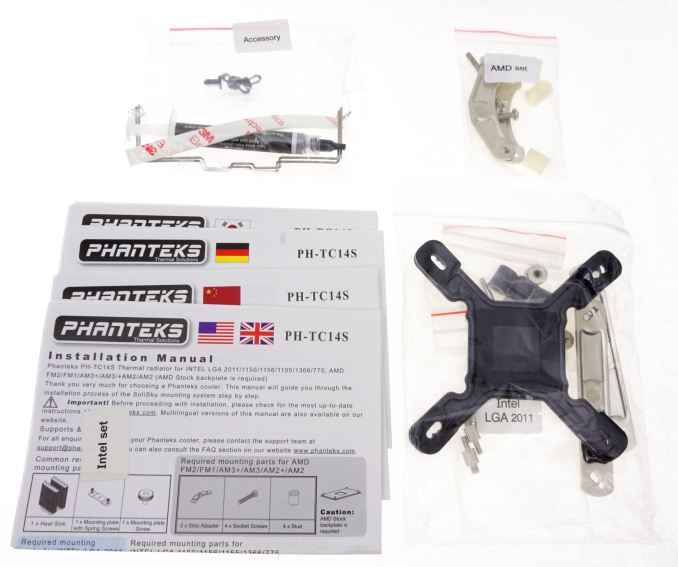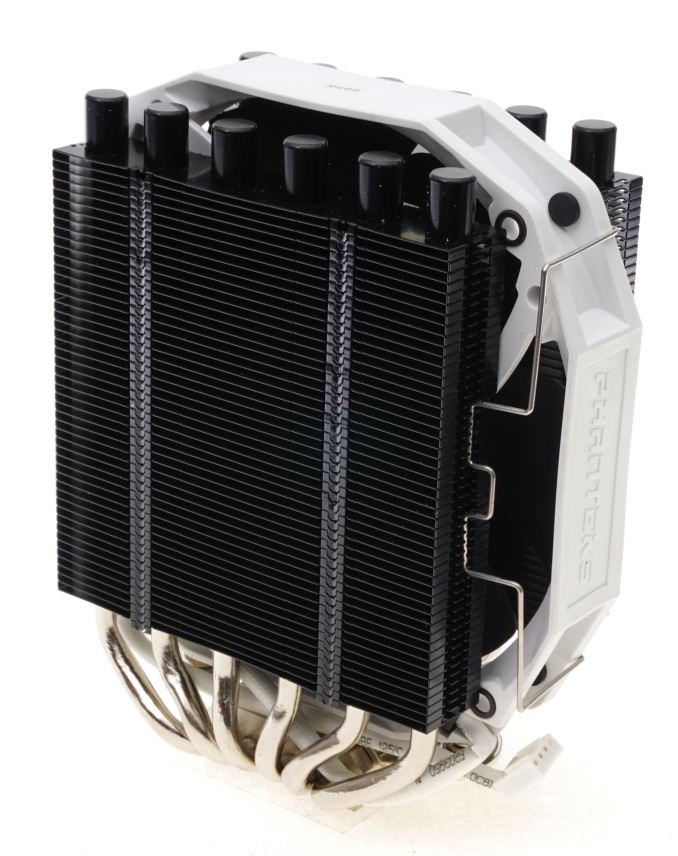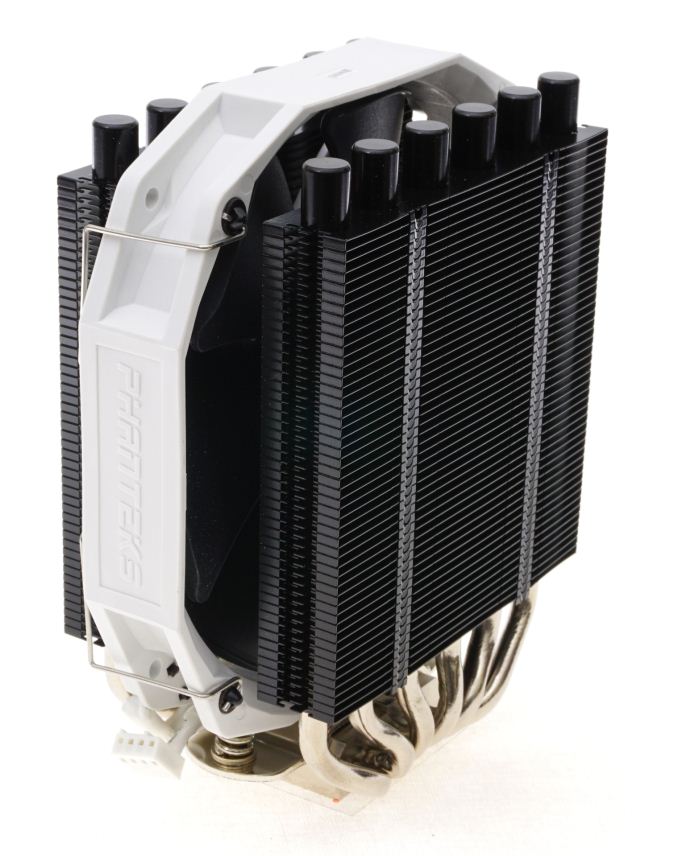The 140mm Slim Tower CPU Cooler Roundup: Thin & Light Done Just Right
by E. Fylladitakis on May 24, 2017 8:00 AM EST- Posted in
- Cases/Cooling/PSUs
- be quiet!
- Noctua
- Phanteks
- Cooler
- Thermalright
Phanteks PH-TC14S
Phanteks supplies the PH-TC14S inside a dark cardboard box with an abstract aesthetic theme, mostly based on schematic drawings of the cooler itself. It is not a very large box for a cooler that size, but it is very sturdy and the cooler is protected with polystyrene foam packaging, making it nearly impossible to damage during transport.
Inside the box we found four manuals, one for each of the most popular languages in the regions that the cooler is being marketed into, the necessary mounting hardware and a syringe with Phanteks PH-NDC thermal compound that should last for at least a couple of applications.
The Phanteks PH-TC14S is the “cheater” of this review, as it is not a single tower but a dual tower cooler design. It technically is a baby version of the monstrous PH-TC14PE that we had a look at a couple of years back. Still, this is Phanteks' only slim 140 mm tower cooler offering, and it is of comparable size to every other cooler in this roundup review. What the designers of Phanteks did was to split the single tower array into two very narrow arrays and place the 140 mm fan in between them. Strangely, the fins are significantly smaller than the fan without any apparent reason, meaning that there will be a significant loss of airflow to every direction.
The array fins are very thin and not strong individually, but they are soldered on the thick heatpipes that are only a few millimeters apart from each other. One major feature of the PH-TC14S is its black fins. Phanteks calls this paint job "Physical Antioxidant Thermal Shield" (or Physical Antioxidant Thermal Spraying - we found both in the company's texts) and claims that it enhances thermal performance by both increasing the dissipation rate of the heatsink itself and decreasing the radiation absorption rate from other heat sources. Unlike the PH-TC14PE, the PH-TC14S is available only in black.
The PH-F140HP fan also is a primary marketing focus of this product. It has the lowest RPM rating of every fan in this review (1300 RPM) but impressively high static pressure specifications (1.64 mm H2O at max speed).
Six thick heatpipes expand to either side of the small base. With the fin arrays placed in parallel, each heatpipe enters both arrays. Although that design appears very symmetric and effective at first, it actually does not appear to be optimal, as the two middle heatpipes that will be right above the CPU core and will be facing the bulk of the heat transfer enter near the fin arrays near the middle, where the fan’s airflow will be the lowest due to the dead spot under its motor.
The rectangular copper base of the PH-TC14S and the copper heatpipes are all nickel plated. Like with the majority of modern coolers, the base of the PH-TC14S is made of two parts, a copper contact plate and an aluminum top frame. The lower half of the base handles the thermal energy transfer away from the CPU and to the heatpipes, while the top half only offers mechanical cohesion and support for the steel mounting brackets. The nickel plated base is very smooth and machined down to a near-perfect mirror finish.
















74 Comments
View All Comments
Yuriman - Wednesday, May 24, 2017 - link
Nice review! Please do more of these.One thing I'd like to see is to have the coolers' thermal resistance normalized for noise. I understand that's not an easy task, but it would be nice to see how much each can dissipate at a given noise level (the only two metrics most people really care about), rather than having both noise and resistance being variables.
Paapaa125 - Wednesday, May 24, 2017 - link
I agree, that would be the best data. If not feasible, I'd like to see the thermal characteristics of each cooler using the same fan at the same speed (tested at many levels).Lolimaster - Thursday, May 25, 2017 - link
Ryzen 7 1700 + Hyper 212X <45°C at load @900rpm, can't even hear the thing.fanofanand - Thursday, May 25, 2017 - link
There are way more variables loli, what kind of case do you have? Any added insulation? What's the average sound level in your room? Do you have a high powered GPU that drowns out the CPU cooler? Do you have loud case fans? Do you have a loud PSU? I'm sure you have a very nice system so having a normalized test would clear up the questions for everyone rather than anecdotal "I can't hear it" statements. Not trying to attack what you are saying but I 3rd the idea that normalized testing for performance at a specific sound level would be great. Even then, different sounds can be more grating than others depending on the pitch. This is probably the hardest area of computing to test, is sound.Lolimaster - Saturday, May 27, 2017 - link
Cheapo case, only fans are the cpu, psu (a seasonic) and a RX560 a low rpm + undervolt.The only thing I actually hear are my 3 HDD's, if I boot without those is basically the expected electric hum.
My place is quite silent.
Gigaplex - Monday, May 29, 2017 - link
If you can't hear the Hyper 212X @900rpm you may need to get your ears checked.JocPro - Monday, May 29, 2017 - link
Same here, R7 1700 + Thermaltake NiC L32 (It's a Slim 140mm tower - why wasn't in the review?) 500 RPM idle, ~600 RPM load... I can't hear it, even trying. The case has 4 CM Silencio PWM @ 900 RPM, and only the air pushed is audible.jospoortvliet - Friday, May 26, 2017 - link
I would prefer to see coolers sped up to the point they produce a fixed amount of noise (say 38db or so) and then compare how much they cool. A much better way to compare them.Robotire - Wednesday, May 24, 2017 - link
Interesting topic but I have a hard time getting useful information out of this article. I would have prefered to see noise levels and efficiency at idle and at full CPU load instead of these artificial 7V and 12V levels. Also there is no easy to read conclusion to help people in a hurry choose the best cooler for their need, and I have no idea what the thermal resistance values mean.mgilbert - Wednesday, May 24, 2017 - link
When it comes to air coolers, there's Noctua, then there is everyone else. They are superior in virtually every respect, especially quality and support.